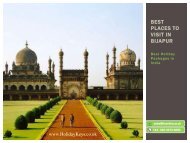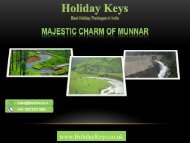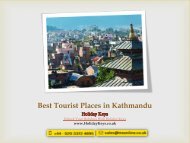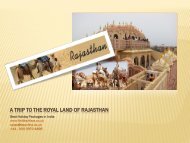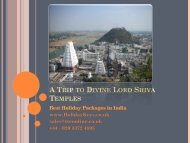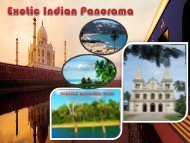Best Tourist Places in Lucknow, India - HolidayKeys.co.uk
Lucknow is the capital of Uttar Pradesh; it is about an elevation of 123 meters above from the sea level. It is widely known for its Ganga Jamuni tahzeeb, that flourished through north Indian cultural and artistic hub and it was also a seat of the Nawabs. Lucknow and some parts of Awadh were ruled by the Delhi Sultanate, Sharqi Sultanate, Mughal Empire, the Nawabs of Awadh, the British East India Company (EIC) and the British Raj. It is famous for many things, but one most famous is Dusshehri mangoes. It is one of the three Gharanas of classical dance Katthak, the Nawabs were very fond of music and dance. Two languages are spoken here Hindi and Urdu.
Lucknow is the capital of Uttar Pradesh; it is about an elevation of 123 meters above from the sea level. It is widely known for its Ganga Jamuni tahzeeb, that flourished through north Indian cultural and artistic hub and it was also a seat of the Nawabs. Lucknow and some parts of Awadh were ruled by the Delhi Sultanate, Sharqi Sultanate, Mughal Empire, the Nawabs of Awadh, the British East India Company (EIC) and the British Raj. It is famous for many things, but one most famous is Dusshehri mangoes. It is one of the three Gharanas of classical dance Katthak, the Nawabs were very fond of music and dance. Two languages are spoken here Hindi and Urdu.
You also want an ePaper? Increase the reach of your titles
YUMPU automatically turns print PDFs into web optimized ePapers that Google loves.
<strong>Lucknow</strong> is the capital of Uttar Pradesh; it is about an elevation of 123 meters above from the sea level.<br />
It is widely known for its Ganga Jamuni tahzeeb, that flourished through north <strong>India</strong>n cultural and artistic<br />
hub and it was also a seat of the Nawabs. <strong>Lucknow</strong> and some parts of Awadh were ruled by the Delhi<br />
Sultanate, Sharqi Sultanate, Mughal Empire, the Nawabs of Awadh, the British East <strong>India</strong> Company (EIC)<br />
and the British Raj. It is famous for many th<strong>in</strong>gs, but one most famous is Dusshehri mangoes. It is one of<br />
the three Gharanas of classical dance Katthak, the Nawabs were very fond of music and dance. Two<br />
languages are spoken here H<strong>in</strong>di and Urdu.<br />
Many i<strong>co</strong>nic build<strong>in</strong>gs were built <strong>in</strong> British and Mughal era that shows different styles of architecture,<br />
more than half of these build<strong>in</strong>gs lies <strong>in</strong> the old city, among these extant architecture, there are religious<br />
build<strong>in</strong>gs such as Imambaras, mosques, and other Islamic shr<strong>in</strong>es as well as secular structures such as<br />
enclosed gardens, baradaris, and palace <strong>co</strong>mplexes.<br />
‘umi Darwaza is an example of Awadhi architecture, built by Nawab Asaf – Ud – Daula, <strong>in</strong> 1784; it is an<br />
entrance of the city. It is sixty feet tall. The road stretches from Rumi Darwaza to Chattar Manzil which<br />
served as the palace of Awadh rulers and their wives. It is also known as Umrella Palae. It was<br />
<strong>co</strong>nstructed by Nawab Ghazi Udd<strong>in</strong> Haider and <strong>co</strong>mpleted after his death by his successor, Nawab Nasir<br />
Udd<strong>in</strong> Haider. It stands on the banks of Gomati River. It <strong>co</strong>nsists of Bari Chattar Manzil and Choti<br />
Chattar Manzil, but only the Bari Chattar Manzil still exists. These two build<strong>in</strong>gs are a tremendous model<br />
of the Indo-European-Nawabi architectural style. The palace was named after the chattaris, which are<br />
umbrella shape domes, on the octagonal pavilions, which crown the build<strong>in</strong>gs. The impos<strong>in</strong>g build<strong>in</strong>g has<br />
larger underground rooms and a dome surmounted by a gilt umbrella.
The Tile Wali Masjid, Fidaye Khan Koka the governor dur<strong>in</strong>g the reign of Shahjahan, had built this<br />
mosque. He was the disciple of Shah Pir Mohd built the mosque, <strong>in</strong>cidentally the first namaz was offered<br />
at the mosque was that of Alvida, from then its be<strong>co</strong>me a ritual which is be<strong>in</strong>g held for the 350 years<br />
without <strong>in</strong>terruption.<br />
The Bara Imambara was built by Asaf – Ud – Daula, Nawab of Awadh <strong>in</strong> 1784, also known as Asafi<br />
Imambara. It was orig<strong>in</strong>ally built to provide assistance affected by the deadly fam<strong>in</strong>e. The <strong>co</strong>mplex also<br />
<strong>in</strong>cludes the large Asaf mosque, the bhul bhulaiya, a bowli, and two impos<strong>in</strong>g g gateways lead<strong>in</strong>g to the<br />
ma<strong>in</strong> hall. It has largest hall of Asia which does not have any external support from wood, iron or stone<br />
beams <strong>co</strong>nta<strong>in</strong><strong>in</strong>g the tomb of Asaf – Ud – Daula. It has eight surround<strong>in</strong>g chambers built to different<br />
roof height, <strong>co</strong>nnect<strong>in</strong>g with each other with 489 doorways.<br />
Next is Chota Imambara situated near Bara Imambara on the <strong>co</strong>nnect<strong>in</strong>g road stands an impos<strong>in</strong>g<br />
gateway known as Rumi Darwaza, is an also known as Hussa<strong>in</strong>abad Imambara built by the third<br />
Nawab of Awadh Muhammad Ali Shah <strong>in</strong> 1838. This build<strong>in</strong>g is known as Palace of Lights because of its<br />
de<strong>co</strong>rations dur<strong>in</strong>g special festivals like Muharram. It also housed the crown of Muhammad Ali Shah and<br />
ceremonial tazias. It has a glided dome any several turrets and m<strong>in</strong>arets. It has several tombs, <strong>in</strong>clud<strong>in</strong>g<br />
the tomb of Muhammad Ali Shah and other members of his family. It <strong>in</strong>cludes two replicas of Taj Mahal<br />
built as the tomb of Muhammad Ali “hahs daughter and her husband. Its walls are de<strong>co</strong>rated with<br />
Arabic calligraphy.
Outside the immambara there is an <strong>in</strong><strong>co</strong>mplete watch tower, named as Satkhanda built <strong>in</strong> 1837 – 1842<br />
at the time of Muhammad Ali Shah, its name is Satkhanda though it has only four stories, and the reason<br />
is Muhammad Ali “hahs death. He wanted to make it the same as Qutub M<strong>in</strong>ar <strong>in</strong> Delhi and the lean<strong>in</strong>g<br />
tower of Pisa.<br />
Dilkusha Kothi as it is named, it is the most delightful place, it is an 18th century house built <strong>in</strong> the<br />
English baroque style, there are a few towers and external walls rema<strong>in</strong> as a monument, and a<br />
widespread garden. The house was <strong>co</strong>nstructed around 1800 by the British Major Gore Ouseley, a friend<br />
of Awadh ruler, Nawab Saadat Ali Khan. It was <strong>in</strong>itially <strong>in</strong>tended as a hunt<strong>in</strong>g lodge for the Nawabs of<br />
Oudh, although it was later used as a summer resort. It is located on the banks of Gomati River. You can<br />
visit there to see its beauty, and nearby places as La Mart<strong>in</strong>iere College.<br />
There are also some places where you can go for a visit, Ambedkar Memorial Park, Janeshwar Mishra<br />
Park. When you will visit <strong>Lucknow</strong> eat some yummy Nawabi cuis<strong>in</strong>e like kakori, galawati, shami, boti,<br />
patili-ke, ghutwa, seekh, Nahari, Sheermal. You can buy some chikankari, zari, zardozi, kamdani, and gota<br />
embroidery outfits like sarrees, kurta, scarfs, etc. You will like this trip to <strong>Lucknow</strong> monuments.







